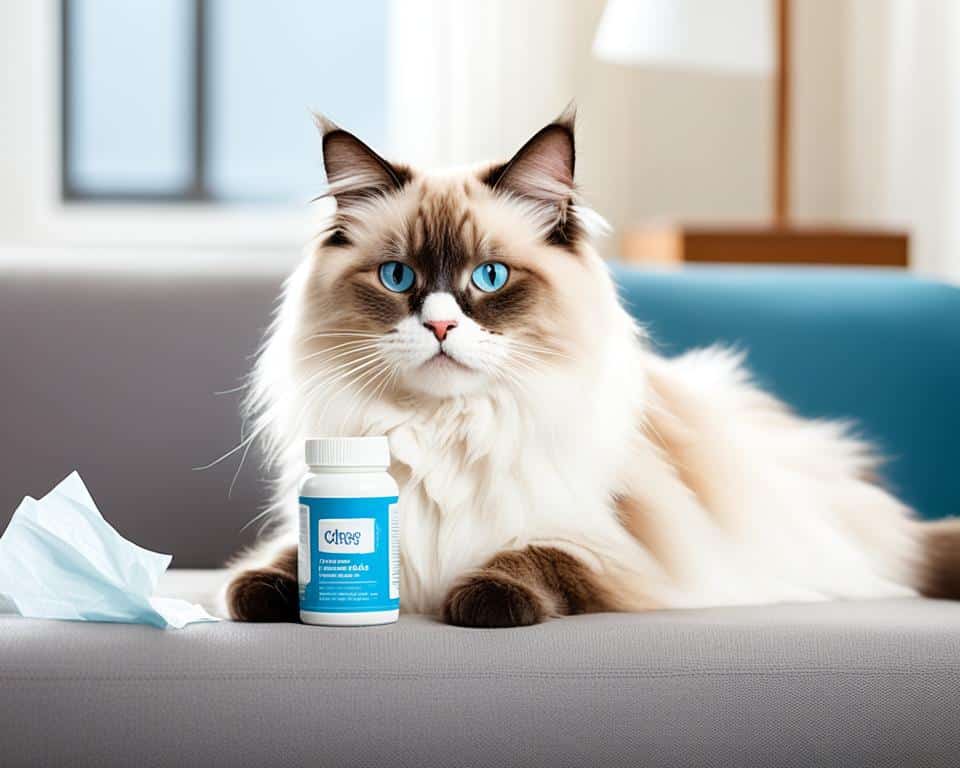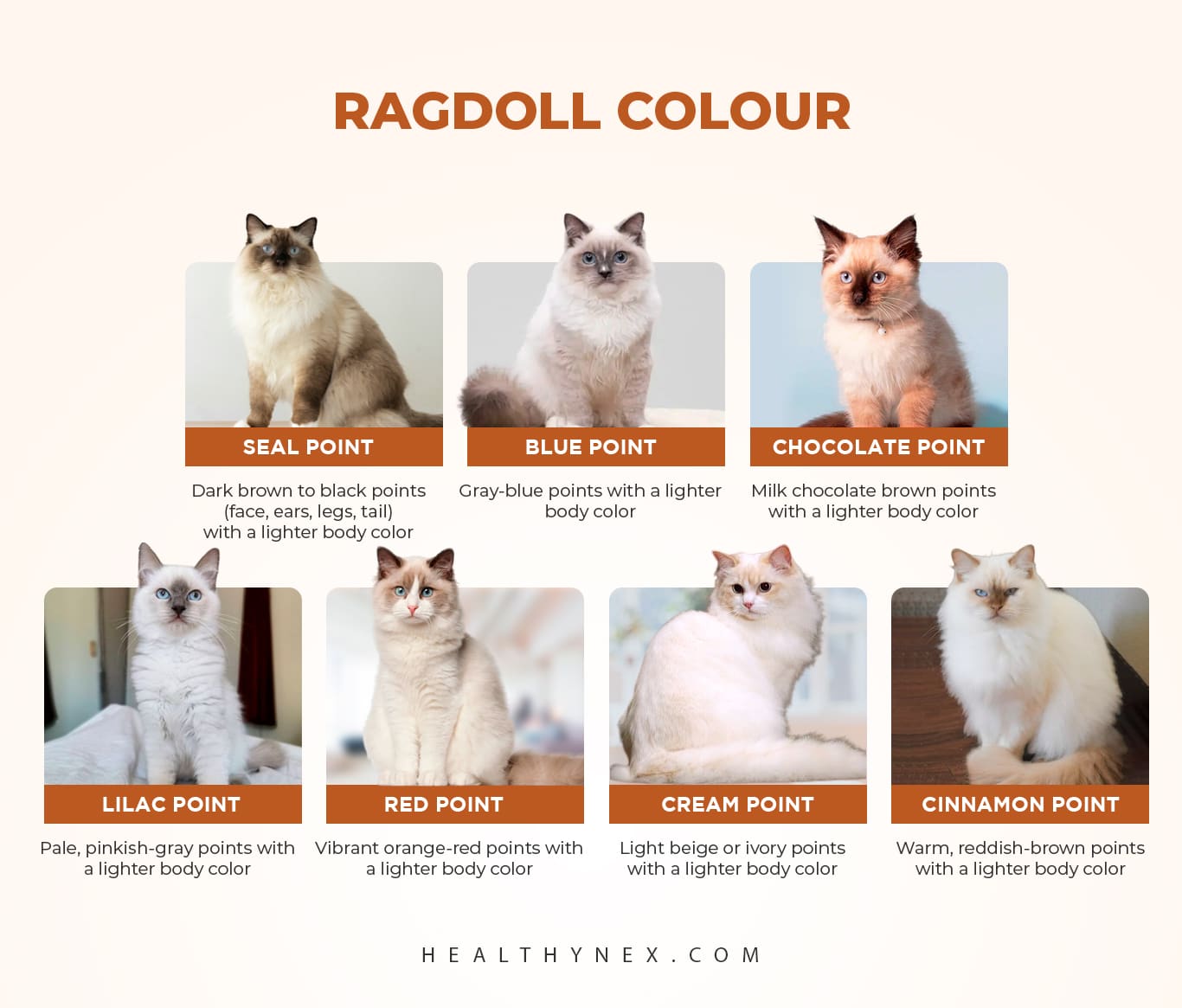Ragdoll cats are truly impressive, known for their large size and beautiful looks. They have stunning blue eyes and soft coats. Their size is similar to that of Maine Coons and Norwegian Forest Cats.
Knowing about Ragdoll cat weights is key to caring for them. Male Ragdolls can grow up to 9.1 kg. Female Ragdolls are a bit smaller, weighing about 15 to 25 percent less than males. This size difference is common among big cat breeds.
Ragdolls grow slowly, taking up to four years to reach their full size. This slow growth is different from smaller cat breeds that grow faster.
From tiny kittens to big cats, Ragdolls have sturdy bodies and strong muscles. They have big frames, long legs, and broad heads. This helps them carry their weight while staying agile and graceful.
Key Takeaways
- Male Ragdolls can weigh up to 9.1 kg when fully mature
- Female Ragdolls are typically 15-25% smaller than males
- Ragdolls take up to 4 years to reach their full adult size
- Birth weight ranges from 85-115 grams (3-4 ounces)
- These cats have sturdy bodies with muscular builds and broad heads
- Ragdolls rank among the largest domestic cat breeds alongside Maine Coons
Understanding Ragdoll Cat Size and Weight Standards
Ragdolls are known for their large size and gentle nature. They follow specific breed standards that make them stand out. Their size and build make them one of the most recognizable large cat breeds.
Ragdolls as Large-Breed Cats
Ragdolls are classified as large-breed cats. Males can be 43-53 cm long and 23-28 cm tall. This is bigger than the average domestic cat, which is 40-46 cm long and 20-25 cm tall. The weight difference is also notable.
Comparison to Other Large Cat Breeds
Ragdolls are among the largest domestic cat breeds. Here’s how they compare:
| Breed | Male Weight Range (kg) | Female Weight Range (kg) |
|---|---|---|
| Ragdoll | 5.4-9.1 | 3.6-6.8 |
| Maine Coon | 6.8-11.3 | 4.5-6.8 |
| Norwegian Forest Cat | 5.4-7.7 | 3.6-5.4 |
| British Shorthair | 5.4-8.2 | 3.6-5.4 |
Factors That Influence Final Size
Several factors affect a Ragdoll’s size. Genetic makeup is the main factor, as DNA determines size. Proper nutrition during growth is crucial for reaching full size. Neutering can also impact size, making cats slightly larger due to hormonal changes.
Complete Ragdoll Weight Chart kg by Age
Keeping an eye on your Ragdoll’s weight is key to their health. These big cats grow differently than others. A detailed ragdoll growth chart is vital for tracking their growth. Knowing what’s normal at each stage helps spot health issues early.
Kitten Weight Milestones (Birth to 12 Months)
Ragdoll kittens grow fast in their first year. They start at 85 to 115 grams at birth. They double their weight in the first week and triple it by four weeks, reaching 200 to 250 grams. Here’s a kitten weight chart to guide you:
| Age | Average Weight (kg) | Weight Range (kg) |
|---|---|---|
| 1 month | 0.3 | 0.25 – 0.35 |
| 2 months | 0.7 | 0.6 – 0.8 |
| 3 months | 1.4 | 1.2 – 1.6 |
| 4 months | 1.8 | 1.6 – 2.0 |
| 6 months | 2.7 | 2.0 – 4.0 |
| 8 months | 3.2 | 2.8 – 3.6 |
| 12 months | 3.6 | 2.8 – 4.0 |
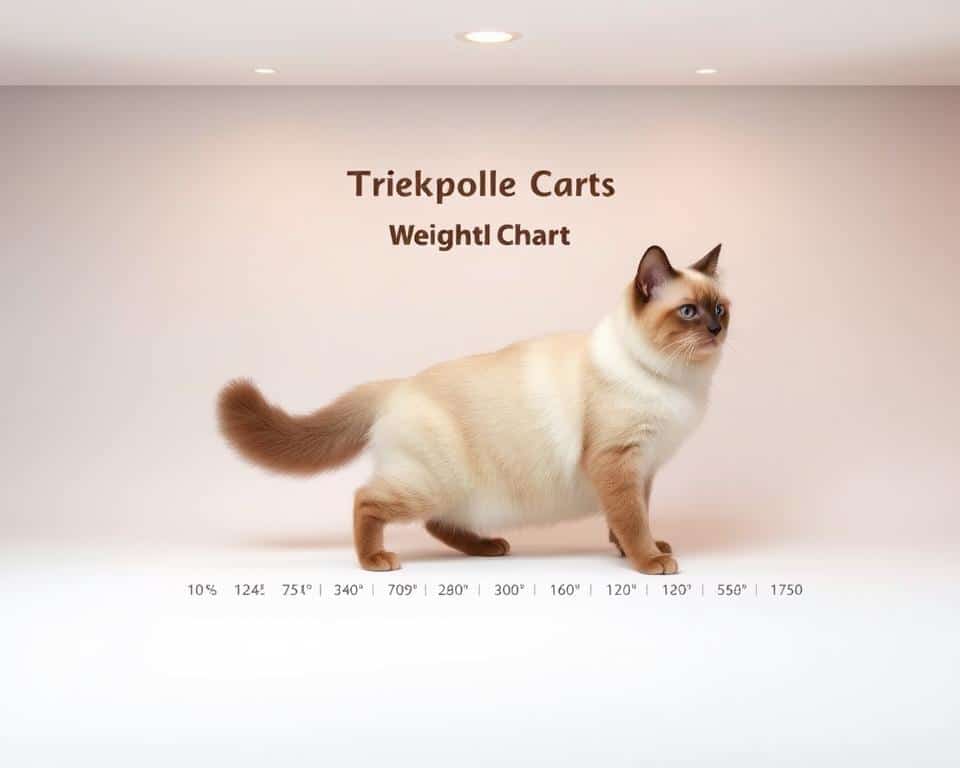
Adolescent Growth Phase (1-2 Years)
After one year, Ragdolls grow slower. Males weigh about 3.6 kg at one year and 6.8 kg by two. Females are a bit smaller, weighing 2.7 kg at one year and 5.1 kg by two. Their bodies fill out and muscles grow a lot during this time.
Adult Weight Development (2-4 Years)
Ragdolls keep growing until they’re four years old. Adult males usually weigh 8.2 kg by three and 9.1 kg by four. Females weigh 6.1 kg by three and 6.8 kg when fully grown. These weight milestones are averages. Cats can vary based on their genes, diet, and how active they are. Keeping an eye on their weight ensures they stay healthy.
Male vs Female Ragdoll Weight Differences
Ragdoll cats show clear size differences based on gender as they grow. Like many cat breeds, males are larger than females. Knowing these differences helps owners plan their cat’s diet and growth.
Average Male Ragdoll Weights
Males can weigh between 5.4 to 9.1 kilograms (12 to 20 pounds). Some males can even be heavier. By one year, males usually weigh about 3.6 kilograms. They reach their full size by age four.
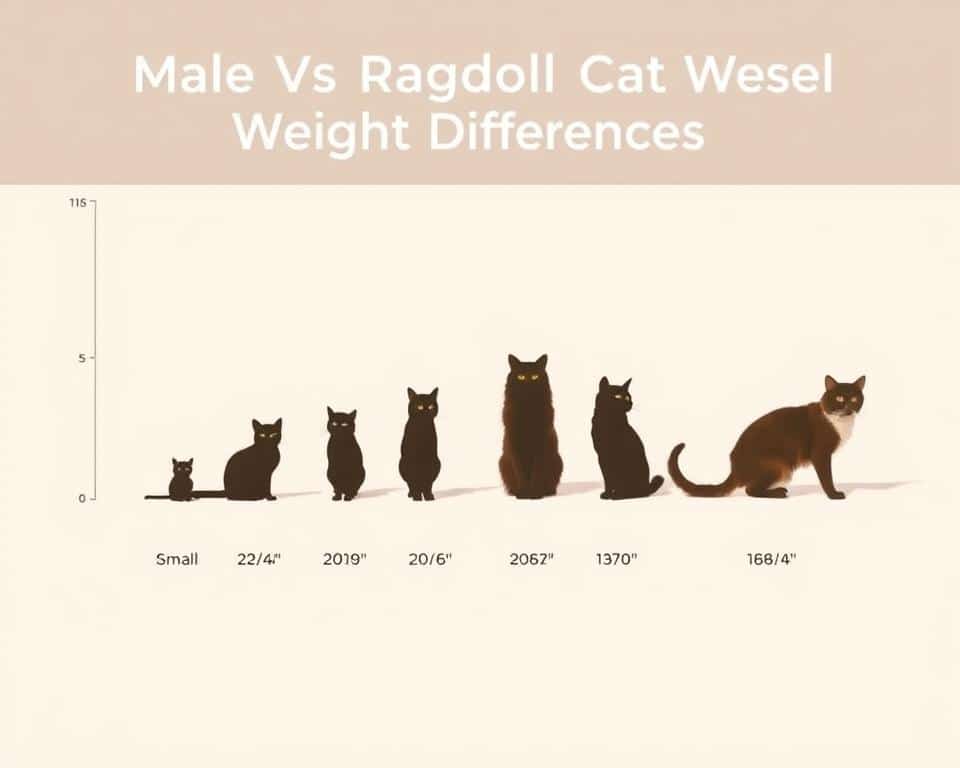
Average Female Ragdoll Weights
Females typically weigh between 3.6 to 6.8 kilograms (8 to 15 pounds) when fully grown. At one year, they usually weigh about 2.7 kilograms. Females are smaller and have finer bones.
Size Variations Between Genders
Females are 15 to 25 percent smaller than males in all ways. This size gap grows more as they get older. Weight alone doesn’t tell the whole story – males also have longer bodies, taller heights, and larger paws.
Ragdoll Growth Timeline and Development Stages
Knowing your Ragdoll’s growth timeline is key to tracking their progress and ensuring they get the care they need. These big cats have a unique growth pattern that makes them stand out from other breeds.
In the first weeks, Ragdoll kittens change fast. Their eyes open around two weeks, showing off their blue color. By four weeks, they can hear fully and their weight triples, reaching 200-250 grams. This early stage lays the groundwork for their adult size.
Between six and twelve weeks, kittens grow even more. They become more active and curious. By twelve weeks, they usually weigh between 900 grams and 1.4 kilograms, ready for their new homes.
| Age Range | Weight Range | Key Developments |
|---|---|---|
| Birth – 6 weeks | 70g – 250g | Eyes open, hearing develops |
| 6 – 12 weeks | 250g – 1.4kg | Active exploration begins |
| 6 – 12 months | 2.5kg – 5kg | Reach adult height |
| 1 – 4 years | 4kg – 9kg | Muscle mass increases |
The most interesting thing about Ragdolls is their long growth period. Unlike most cats, which stop growing by 18 months, Ragdolls keep growing until they are four years old. After one year, they mainly build muscle, not grow taller or longer.
Factors Affecting Your Ragdoll’s Weight
Knowing what affects your Ragdoll’s weight is key to caring for them. These big cats come in different sizes due to many factors. From genetics to how active they are, each plays a part in their size.
Genetic Makeup and DNA Influence
Genetics play a huge role in your Ragdoll’s size. Their DNA from parents and ancestors shapes their bones, muscles, and size. This genetic plan decides how big your cat will be.
Some Ragdolls grow bigger than others, thanks to their genes. Your cat’s maximum size is set before they’re born. This is why two Ragdolls on the same diet can grow to different sizes.

Impact of Neutering on Size
Neutering changes how Ragdolls grow. Neutered cats can grow up to 10% bigger than unneutered ones. This is because sex hormones help growth plates close. Without them, bones keep growing.
Neutering early, before six months, makes cats even bigger. Indoor neutered cats might gain weight more easily because they’re less active. It’s important to watch their size to keep them healthy.
Diet and Feeding Regimen
Your Ragdoll’s diet mainly affects their body shape, not size. Good food helps muscles and fat stay healthy. Choose premium cat food with the right proteins and nutrients, but in smaller amounts.
- High-quality proteins build lean muscle mass
- Proper portion control prevents unhealthy weight gain
- Scheduled feeding times regulate metabolism
- Fresh water availability supports overall health
Ragdolls grow at their own pace, with ups and downs. They need regular meals to grow healthily. This helps them stay in good shape as they grow.
Healthy Weight Management for Ragdoll Cats
Starting with ragdoll weight management means knowing your cat’s lifestyle needs. Since Ragdolls stay indoors, they face unique challenges. A balanced diet and activity keep them at the right weight for their whole life.
Identifying Ideal Body Condition
A healthy body condition score for your Ragdoll means you can feel their ribs with gentle pressure but not see them. Their waist should be visible from above, showing a slight hourglass shape. Look for these signs of proper weight:
- Ribs easily felt but not visible
- Minimal fat covering the abdomen
- Clear waist when viewed from above
- No sagging belly when viewed from the side
Preventing Obesity in Indoor Ragdolls
To prevent obesity, understand your cat’s natural behavior. Wild cats hunt many times a day, eating small portions. Indoor Ragdolls need similar feeding patterns. Try splitting their daily food into 4-5 small meals instead of leaving it out all day.
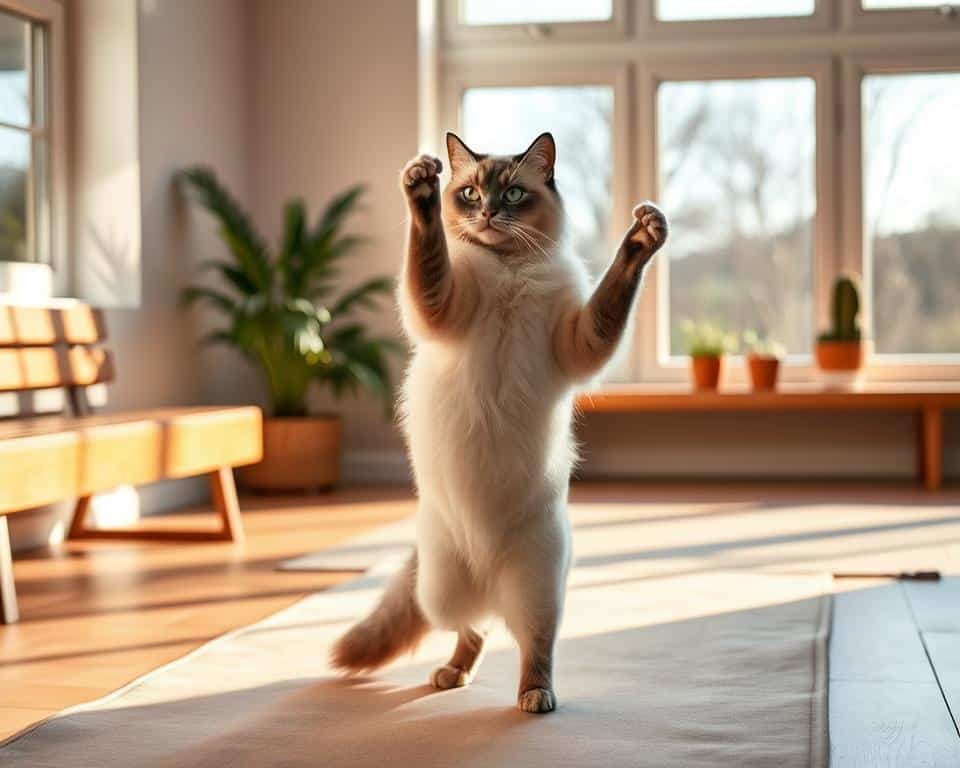
Exercise Requirements for Weight Control
Regular indoor cat exercise keeps Ragdolls fit and active. They prefer activities on the ground rather than climbing. Here are some exercise ideas:
- Feather wands for hunting simulation
- Rolling balls across the floor
- Puzzle feeders for mental stimulation
- Short play sessions every few hours
Ragdolls naturally rest up to 19 hours a day. Focus on quality over quantity with exercise sessions lasting 10-15 minutes each.
Nutrition Guidelines for Optimal Ragdoll Weight
Proper ragdoll nutrition is key to keeping your cat at the right weight. Ragdolls, being large cats, have special dietary needs. Knowing their cat food requirements helps avoid weight problems.
A healthy diet for Ragdolls focuses on animal-based proteins. Their meals should have at least 50% protein from chicken, beef, salmon, or mackerel. This supports muscle growth and keeps them lean.
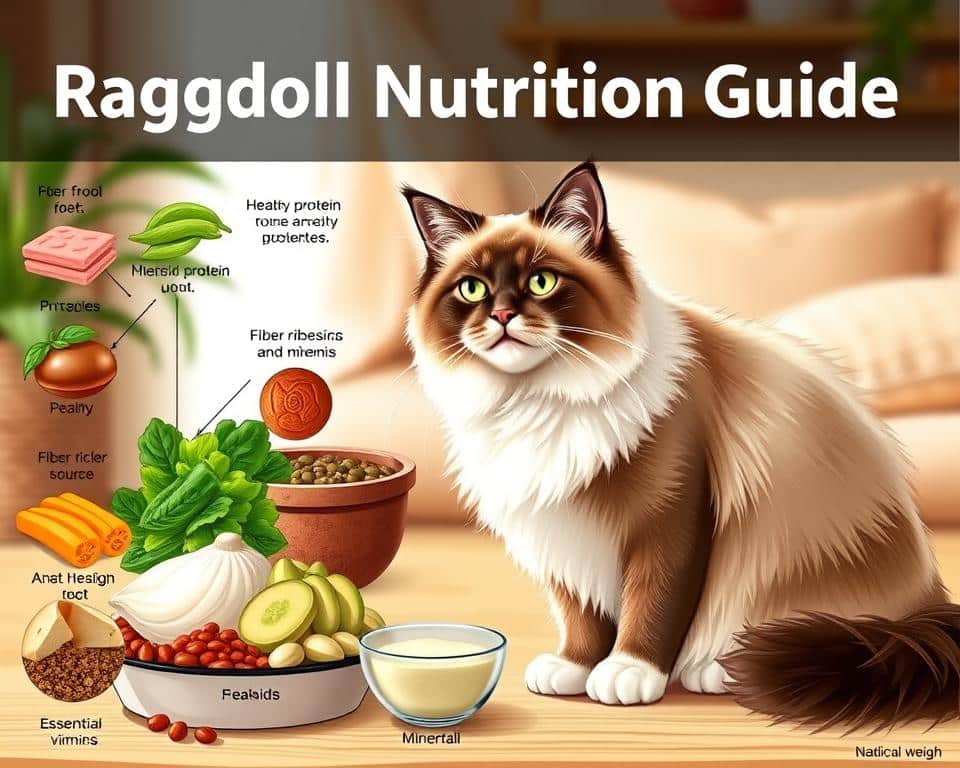
Choosing the right food is crucial to meet your Ragdoll’s protein needs. The best diet includes:
- 50% or more animal protein
- Up to 20% healthy animal fats
- Less than 3% carbohydrates
- No artificial colors or preservatives
Plant-based proteins like soy, corn, or wheat are not enough for cats. They can cause weight gain because cats can’t digest them well. Too many carbs also stress the pancreas and lead to fat storage.
Wet food is better than dry kibble for cat food requirements. It has more meat and fewer fillers. This helps control portions and gives the right nutrients. Choose grain-free options with real meat first to support a healthy diet and weight control.
Common Weight-Related Health Concerns
Keeping your Ragdoll at a healthy weight is key to avoiding health problems. These big cats need special care because of their size. A good weight helps them live a better life.
Risks of Being Underweight
Underweight Ragdolls face big health risks. Not enough food when they’re young can harm their bones and muscles. They might have:
- Weakened immune system
- Poor muscle development
- Delayed maturity
- Lower energy levels
Feeding them right when they’re growing helps them have strong bones and muscles.
Health Issues from Excess Weight
Indoor Ragdolls are at high risk for obesity. Too much weight can hurt their hearts and joints. They often get heart disease, affecting almost 3% of the breed. Overweight cats may also have:
- Increased heart disease risk
- Higher chance of urinary problems
- Joint stress and arthritis
- Breathing difficulties
Even though Ragdolls are less likely to get diabetes, being overweight is still a big health risk.
Mobility Problems in Large-Breed Cats
Big cats like Ragdolls often have trouble moving as they get older. Carrying extra weight puts more pressure on their hips and joints. They’re especially prone to hip dysplasia and arthritis. Keeping them at a healthy weight helps prevent these problems. Studies show that with proper care, Ragdolls can live up to 10 years, with weight management being crucial.
Monitoring Your Ragdoll’s Weight Progress
Keeping an eye on your Ragdoll cat’s weight is key to their health. These big cats need regular checks to grow right and stay in shape.
Begin tracking your Ragdoll’s growth early on. Weigh them weekly in their first year, then monthly as adults. Use a log or app to track their weight. This info helps your vet catch problems early.
- Steady growth without sudden drops or spikes
- Active, playful behavior with good energy levels
- A visible waist when viewed from above
- Ribs that can be felt but not seen
- Shiny, soft coat texture
Adult Ragdolls should see the vet every six months. Your vet will check their body condition and suggest changes if needed. Keep an eye out for signs like tiredness, loss of appetite, or digestive issues that could mean weight problems.
Good food is important for your Ragdoll’s growth. Premium diets can boost energy, clean litter boxes, and help them stay lean. By month four, they’ll likely have a shinier coat and better muscles.
Ragdoll kittens grow in bursts, not steadily. If their weight seems to stall, don’t worry. Look at the big picture, not just week-to-week changes.
Conclusion
This summary shows that Ragdolls grow slowly to their full size. They take up to four years to reach their adult weight, longer than most house cats. Male Ragdolls weigh between 5.4 and 9.1 kilograms, while females weigh 3.6 to 6.8 kilograms.
These cats start as tiny 85 to 115 gram newborns. They grow into the large, fluffy companions we love.
Keeping your Ragdoll healthy starts with knowing their needs. Feed them a diet rich in animal protein to support their size. Regular play helps keep them active and prevents weight gain.
Regular vet visits are key to track their growth and catch any health issues early. Your vet can tell if your Ragdoll is at a healthy weight.
Following these tips will help your Ragdoll thrive. Check their body condition by feeling for ribs under their coat. Adjust their food based on their activity level and life stage. Neutered cats may need fewer calories to stay at a healthy weight.
With the right care, your Ragdoll will grow into a happy, healthy companion. They will bring joy to your home for many years.


